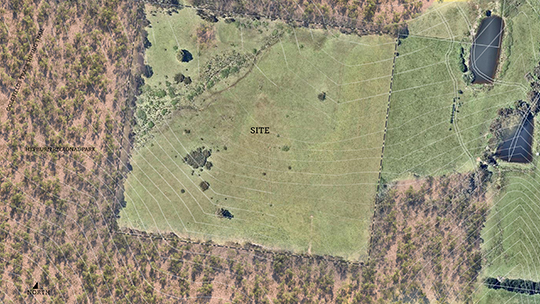Studio 40
The Field: Caretakers of Country
Rochus Urban Hinkel and Dylan Newell

This studio is available to students enrolled in ABPL90142 Studio C, ABPL90143 Studio D, and ABPL90115 Studio E.
Studio Description
Studio 40 engages with questions of Country: Indigenous knowledge systems, and current and past cultural production and histories of place. Our site is former farmland, close to Daylesford, adjacent to bushland, and situated on Dja Dja Wurrung Country. We will study Indigenous seasons, management of Country, and representation of Indigenous culture; developing out of this, study proposals for places of gathering, caretaking, and seasonal housing. The architecture will represent a temporal evolution of the site, responding dynamically to Dja Dja Wurrung cultural and material needs along with the ‘wicked’ problems of our contemporary moment. The project will question who architecture is for and what architecture can be.
Studio 40 engages with larger cultural and environmental questions, from which students will develop a personal socio-political and ethical framework to inform their local design responses. Architectural proposals can range from radical and utopian to detailed and realistic.
Studio Outcomes
We will study relevant literature and undertake a two-day site visit to develop a deeper understanding of the historical, cultural, environmental, and political context. Students will gather knowledge and understanding into maps, collages, and other representations to uncover opportunities and develop their personal project framework. We will develop the designs through consultation workshops, framed through talks, tours, readings, and lectures.
In Studio 40 we use Augmented Reality to develop, represent, and discuss architectural proposals. A physical site model (1:200) and a digital landscape model (Rhino) are available to be used. Students are encouraged to explore tactile design outcomes—model making using 3D printing technology, or building with straw and mud by hand, to name a few. Appropriate training and equipment for utilising augmented reality and making prototypes will be available. We have exhibited past projects in Melbourne Design Week alongside panel discussions (YouTube recordings). Knowledge of Rhino 3D modelling software or equivalent is necessary.
Studio Leaders
Rochus Urban Hinkel has taught architecture at RMIT University and the Art Academy in Stuttgart, further former positions include Professor of Artistic Design, OTH Regensburg, Germany, and Professor of Interior Design and Furniture Design at Konstfack University of Arts, Craft and Design, Stockholm.
Current research includes a traditional owner-led project with the Olkola Aboriginal Corporation at Cape York together with Dr. Hannah Robertson (MSD). His VR project 'Voices of Country', developed with the NExT Lab (MSD), Prof Hélène Frichot and Büro Achter April, has been presented at the media arts festival Ars Electronica in 2020.
Dylan Newell is a recent graduate of the Master of Architecture at MSD and is now a graduate researcher. His PhD explores, through reflexive architecture practice, whether an ethical framework of Degrowth can build resilience into the suburbs of Melbourne through adaptive and transformative re-use. He has 15 years of industry experience, particularly in ESD, residential design, and school architecture. Dylan is also a permaculture designer with a strong interest in ecology and views the built environment from a landscape systems perspective.
Readings & References
- Cahir, F., Clark, I. D., & Clarke, P. A. (2018). Aboriginal Biocultural Knowledge in South-eastern Australia. Melbourne: CSIRO Publishing.
- Frichot, H., & Hinkel, R. (2020). Voices of Country. Ars Electronica. Retrieved from https://ars.electronica.art/keplersgardens/files/2020/08/Utopia-Voices_of_Country-Essay.pdf
- Gammage, B. (2012), The Biggest Estate on Earth. Crows Nest, NSW: Allen & Unwin.
- Memmott, P. (2007). Gunya, Guoondie + Wurley. St Lucia, Queensland: University of Queensland Press.
- Memmot, P. (1997). Aboriginal Signs and Architectural Meanings. Part 2. ATR (Architectural Theory Review), 38-64.
- Memmott, P. (1996). Aboriginal Signs and Architectural Meanings. Part 1. ATR (Architectural Theory Review), 79-100.
- Pascoe, B. (2014). Dark Emu. Broome: Magabala Books Aboriginal Corporation.
- Sutton, P., & Walshe, K. (2021) Farmers or hunter-gatherers? : the Dark Emu debate. Carlton, VIC: Melbourne University Press, 2021.
- Neale, M., & Kelly, L. (2020). Songlines: The power and promise, Port Melbourne: Thames & Hudson.
Schedule Tuesdays 15:15-18:15 and Thursdays 12:00-15:00
Off-campus Activities Week 4